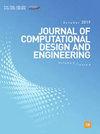基于nurbs的三维图像表面生成:光谱构建和数据驱动的模型选择
IF 6.1
2区 工程技术
Q1 COMPUTER SCIENCE, INTERDISCIPLINARY APPLICATIONS
引用次数: 1
摘要
本文提出了一套从三维图像中恢复cad型表面模型的改进算法。所提出的框架的目标是生成b样条或NURBS曲面,这是数字工程中实体对象的标准数学表示。为了创建NURBS曲面,我们首先使用Marching Cubes算法和Discrete Morse理论从三角形网格计算控制网络(四边形网格)。为了创建NURBS曲面,我们首先使用Marching Cubes算法计算三角形网格,然后使用离散Morse理论从三角形网格确定控制网络(四边形网格)。离散莫尔斯理论使用在三角剖分上定义的特定标量场的临界点来生成一个四边形网格。这样的标量场是通过在三角剖分上求解一个图拉普拉斯特征问题得到的。然而,得到的表面并不是最优的。因此,我们引入了一种优化算法来更好地近似物体的几何形状。此外,我们提出了一种统计方法,用于选择最合适的图拉普拉斯特征函数来生成一个既不太粗糙也不太精细的控制网络,给定三维图像的精度。为此,我们建立了一个回归模型,并使用信息准则来选择最佳曲面。最后,我们扩展了我们的方法,使用概率回归考虑模型和数据的不确定性,并使用哈密顿MCMC对后验分布进行抽样。本文章由计算机程序翻译,如有差异,请以英文原文为准。
NURBS-based surface generation from 3D images: spectral construction and data-driven model selection
In this paper, we present a set of improved algorithms for recovering CAD-type surface models from 3D images. The goal of the proposed framework is to generate B-Spline or NURBS surfaces, which are standard mathematical representations of solid objects in digital engineering. To create a NURBS surface, we first compute a control network (a quadrilateral mesh) from a triangular mesh using the Marching Cubes algorithm and Discrete Morse theory. To create a NURBS surface, we first compute a triangular mesh using the Marching Cubes algorithm, then the control network (a quadrilateral mesh) is determined from the triangular mesh by using discrete Morse theory. Discrete Morse theory uses the critical points of a specific scalar field defined over the triangulation to generate a quad mesh. Such a scalar field is obtained by solving a graph Laplacian eigenproblem over the triangulation. However, the resulting surface is not optimal. We therefore introduce an optimisation algorithm to better approximate the geometry of the object. In addition, we propose a statistical method for selecting the most appropriate eigenfunction of the graph Laplacian to generate a control network that is neither too coarse nor too fine, given the precision of the 3D image. To do this, we set up a regression model and use an information criterion to choose the best surface. Finally, we extend our approach by taking into account both model and data uncertainty using probabilistic regression and sampling the posterior distribution with Hamiltonian MCMC.
求助全文
通过发布文献求助,成功后即可免费获取论文全文。
去求助
来源期刊

Journal of Computational Design and Engineering
Computer Science-Human-Computer Interaction
CiteScore
7.70
自引率
20.40%
发文量
125
期刊介绍:
Journal of Computational Design and Engineering is an international journal that aims to provide academia and industry with a venue for rapid publication of research papers reporting innovative computational methods and applications to achieve a major breakthrough, practical improvements, and bold new research directions within a wide range of design and engineering:
• Theory and its progress in computational advancement for design and engineering
• Development of computational framework to support large scale design and engineering
• Interaction issues among human, designed artifacts, and systems
• Knowledge-intensive technologies for intelligent and sustainable systems
• Emerging technology and convergence of technology fields presented with convincing design examples
• Educational issues for academia, practitioners, and future generation
• Proposal on new research directions as well as survey and retrospectives on mature field.
 求助内容:
求助内容: 应助结果提醒方式:
应助结果提醒方式:


